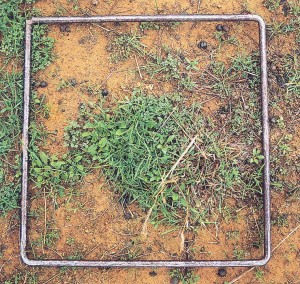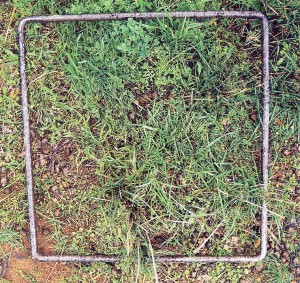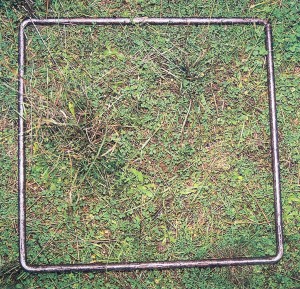Manage ground cover
What is ground cover?
Ground cover can be defined as any material found near to and above the soil surface that protects the soil from the erosive forces of wind, water and traffic. Plant material is the most important component of ground cover.
There are two components to the herbage component (plant material) of ground cover. These are:
- Canopy cover – standing plants (both alive and dead material) helps to minimise wind erosion and rainfall impact.
- Contact cover – herbage in contact with the soil (prostrate stems, leaves, litter) assists in minimising water erosion, wind erosion and rainfall impact.
Ground cover also includes loose litter, dung and rocks which act to protect the soil. In areas prone to wind erosion, the cover needs to be connected to the soil surface.
Why is ground cover important?
Ground cover assists in improving the productivity and the health of the general landscape by:
- Reducing damage to the soil surface caused by rainfall impact,
- Slowing water flow across the soil surface, reducing erosion, run off of nutrients and sediment movement,
- Improving the infiltration of water into the soil,
- Improving the water retention of the soil system,
- Minimise spaces for germination of broadleaf weeds,
- Moving organic matter into the soil system to assist in buffering rapid changes to soil temperatures.
Ground cover – protecting the soil
In areas that have low ground cover, rainfall will not be used as efficiently due to increased runoff and the possible loss of topsoil. One millimetre of topsoil lost by erosion equals about 10 tonnes of lost soil per hectare (Making More From Sheep, module 6 Healthy Soils). Pastures that have adequate ground cover levels maintained throughout the year are likely to be healthier and more resistant to drier periods and seasonal impacts and recover quicker after stress.
Ground cover intercepts rain drops and reduces their destructive force on the soil surface (see figure 1). Canopy and contact cover are both important in protecting soil against raindrop impact and reducing soil loss.
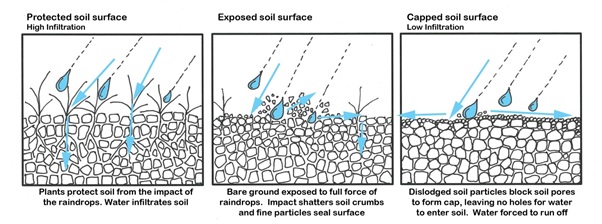
Ground cover also slows the passage of run off water to give it more time to infiltrate soil. See figure 2 for the typical relationship between annual run off of surface water and annual loss through erosion as impacted by ground cover.
As with any other component of the farming system, ground cover needs to be managed as part of the farming enterprise with tactical decisions and options based on clear targets.
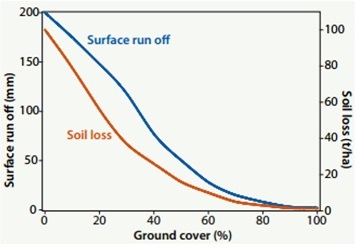
What are the management targets and options?
Points to remember
- Better management of ground cover can reduce run off and increase the amount of rainfall available to plant growth.
- The time of highest erosion risk is generally late summer/early autumn as ground cover is often lowest at this time (dead plant material has broken down over the summer period and new plant growth is yet to occur until the autumn break) and heavy thunderstorms tend to occur.
- Perennial species maintain ground cover better during summer and autumn than annuals.
- Grasses (with their fibrous root systems) are preferable pasture species to those with a tap root. Fibrous roots are more effective at increasing soil organic matter, improving soil structure and maintaining infiltration rates.
Seasonal management
Fencing to land class can assist in managing to ground cover targets. North and south facing slopes should be fenced out separately. Stock can then be removed from paddocks with a northerly aspect as soon as there is a reduction in ground cover and moved to the remaining paddocks where ground cover will not be as severely impacted at that point in time. This also means that ground cover can be managed more precisely.
In autumn it is suggested that paddocks not be grazed below 800 kgDM/ha (kilograms of dry matter per hectare) to ensure at least 70% ground cover (see Figure 3). In steeper paddocks the ground cover target should be as close to 100% as possible, and around 1000 kgDM/ha. There is a relationship between Food On Offer (FOO in kgDM/ha) and ground cover. The Feed On Offer library allows users to estimate FOO and nutritive value of grazed pastures. The principles of grazing management including how to manipulate composition and persistence are described in EverGraze Exchange (Online) – The Nuts and Bolts of Grazing Management.
During winter, grazing should be prevented in wetter areas and paddocks to avoid pugging damage. Pugging can severely damage the roots of the pastures, which may result in lower measured ground cover levels later in the year and into the new year if the pastures fail to recover.
In spring maximising plant growth through rotational grazing will help to accumulate litter. Aim for 2-3 handfuls of litter per 0.1m2 by the end of spring.
In summer, maintain ground cover at 70% on flatter areas and 100% on steeper slopes. This helps to reduce water loss through evaporation and may help extend the growing season, reduces erosion from summer storms and assists in insulating soils from extreme temperatures.
Figure 3. Percentage of ground cover and its effects on the soil and pasture
|
|
|
|
|
|
|
Source: Making More From Sheep, Module 6 Healthy Soils, Tool 6.2
How can I assess ground cover?
There is a tool to assess ground cover on the Meat and Livestock Australia website.
The following steps are a short version of that tool.
Step 1 – Select areas to monitor
- Mark areas on a farm map to allow assessment of ground cover over time
- Make sure the area being assessed is representative of the entire area. Plot a diagonal path or a zigzag across a paddock depending on the size of the area being assessed
Step 2 – Decide on time of year to monitor
- In southern Australia, ground cover is often at its lowest level prior to the autumn break, so this is the best time to assess the risk of soil loss through erosion
Step 3 – Estimate the ground cover
- Using a 30cm x 30cm quadrant or square (make out of sturdy cardboard, timber or wire), walk along the transect you plotted in step 1. Throw the quadrant at random along the transect and visually assess the ground cover in the quadrant. Record the assessment figure. The pictures in Figure 3 can be used as a guide.
- Photographic records can be used as a reminder of what the pasture cover was like. It is important to take the photos in the same spot each year
Further Information
- EverGraze Exchange (Online) – The Nuts and Bolts of Grazing Management
- Dividing Up the Farm for Grazing Management
- Feed On Offer library
- Tools to help estimate kgDM/ha
- Managing ground cover to reduce run-off and water loss, MLA Tips and Tools
- Ground cover in the mid-Murrumbidgee catchment, Best Management Practices for Dryland Cropping Systems, Murrumbidgee Catchment Management Authority
- Assessing Groundcover, More Beef from Pastures Pasture Growth module

